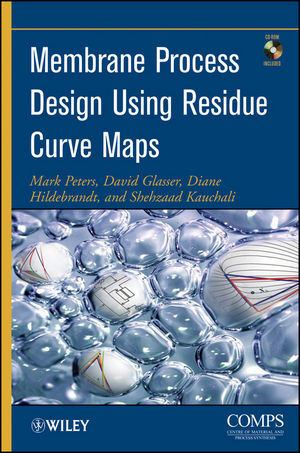Membrane Process Design Using Residue Curve MapsISBN: 978-0-470-52431-2
Hardcover
264 pages
May 2011
 This is a Print-on-Demand title. It will be printed specifically to fill your order. Please allow an additional 10-15 days delivery time. The book is not returnable.
|
||||||
Preface xi
Acknowledgments xiii
Notation xv
About The Authors xix
1 INTRODUCTION 1
2 PERMEATION MODELING 7
2.1 Diffusion Membranes 8
2.1.1 Gas Separation 8
2.1.2 Pervaporation 11
2.2 Membrane Classification 13
3 INTRODUCTION TO GRAPHICAL TECHNIQUES IN MEMBRANE SEPARATIONS 15
3.1 A Thought Experiment 15
3.2 Binary Separations 16
3.3 Multicomponent Systems 20
3.3.1 Mass Balances 21
3.3.2 Plotting a Residue Curve Map 23
4 PROPERTIES OF MEMBRANE RESIDUE CURVE MAPS 29
4.1 Stationary Points 29
4.2 Membrane Vector Field 30
4.3 Unidistribution Lines 31
4.4 The Effect of a-Values on the Topology of M-RCMs 32
4.5 Properties of an Existing Selective M-RCM 34
4.5.1 Case 1: When the Permeate Side Is at Vacuum Conditions (i.e., πP ≈ 0) 34
4.5.2 Case 2: When the Permeate Pressure Is Nonzero (i.e., πP > 0) 36
4.6 Conclusion 38
5 APPLICATION OF MEMBRANE RESIDUE CURVE MAPS TO BATCH AND CONTINUOUS PROCESSES 41
5.1 Introduction 41
5.2 Review of Previous Chapters 44
5.3 Batch Membrane Operation 45
5.3.1 Operating Leaves in Batch Permeation 45
5.3.2 Material Balances 46
5.3.3 Permeation Model 48
5.3.4 Operating Regions: Nonselective Membranes 48
5.3.5 Operating Regions: Selective Membranes 50
5.4 Permeation Time 52
5.5 Continuous Membrane Operation 54
5.5.1 Nonreflux Equipment 54
5.5.2 Reflux Equipment 58
5.6 Conclusion 64
6 COLUMN PROFILES FOR MEMBRANE COLUMN SECTIONS 65
6.1 Introduction to Membrane Column Development 66
6.1.1 Relevant Works in Membrane Column Research 67
6.2 Generalized Column Sections 68
6.2.1 The Difference Point Equation 70
6.2.2 Infinite Reflux 71
6.2.3 Finite Reflux 74
6.2.4 CPM Pinch Loci 76
6.3 Theory 80
6.3.1 Membrane Column Sections 80
6.3.2 The Difference Point Equation for an MCS 81
6.3.3 Permeation Modeling 82
6.3.4 Properties of the DPE 84
6.4 Column Section Profiles: Operating Condition 1 85
6.4.1 Statement 85
6.4.2 Mathematics 85
6.4.3 Membrane Residue Curve Map 85
6.5 Column Section Profiles: Operating Condition 2 87
6.5.1 Statement 87
6.5.2 Mathematics 87
6.5.3 Column Profile 88
6.5.4 Analysis 89
6.5.5 Pinch Point Loci 93
6.5.6 Further Column Profiles 94
6.5.7 Direction of δT 96
6.5.8 Direction of Integration 96
6.5.9 Crossing the MBT Boundary 97
6.6 Column Section Profiles: Operating Conditions 3 and 4 97
6.6.1 Statement 97
6.6.2 Mathematics 97
6.6.3 Column Profile 98
6.6.4 Pinch Point Loci 99
6.6.5 Analysis of Column Profile 100
6.6.6 Pinch Point 102
6.6.7 Further Column Profiles 102
6.6.8 Variations in XΔ and rΔ 104
6.7 Applications and Conclusion 105
7 NOVEL GRAPHICAL DESIGN METHODS FOR COMPLEX MEMBRANE CONFIGURATIONS 107
7.1 Introduction 108
7.2 Column Sections 110
7.2.1 Definition 110
7.2.2 The Difference Point Equation 111
7.2.3 Vapor–Liquid Equilibrium and Permeation Flux 113
7.2.4 Column Profiles 113
7.3 Complex Membrane Configuration Designs: General 114
7.3.1 Overview 114
7.3.2 Petlyuk Membrane Arrangement 114
7.3.3 Material Balances 116
7.4 Complex Membrane Configuration Designs: Operating Condition 1 117
7.4.1 Statement 117
7.4.2 Mathematics 117
7.4.3 Column Profiles 119
7.4.4 Requirements for Feasibility 120
7.4.5 Analysis and Behavior of Column Profiles 121
7.4.6 Feasible Coupled Columns 124
7.5 Complex Membrane Configuration Designs: Operating Condition 2 132
7.5.1 Statement 132
7.5.2 Mathematics 132
7.5.3 Column Profiles 133
7.5.4 Feasibility 134
7.6 Complex Membrane Configurations: Comparison with Complex Distillation Systems 138
7.7 Hybrid Distillation–Membrane Design 138
7.7.1 Overview 138
7.7.2 Material Balances 140
7.7.3 Feasibility 141
7.8 Conclusion 150
8 SYNTHESIS AND DESIGN OF HYBRID DISTILLATION – MEMBRANE PROCESSES 151
8.1 Introduction 152
8.2 Methanol/Butene/MTBE System 153
8.2.1 Design Requirements 155
8.3 Synthesis of a Hybrid Configuration 156
8.4 Design of a hybrid configuration 159
8.4.1 Column Sections of Hybrid Configuration 159
8.4.2 Degrees of Freedom 161
8.4.3 Generating Profiles for Hybrid Columns 163
8.4.4 Comparing Feasible Design Options 164
8.4.5 Attainable Region 164
8.5 Conclusion 167
9 CONCLUDING REMARKS 169
9.1 Conclusions 170
9.2 Recommendations and Future Work 171
9.3 Design Considerations 172
9.3.1 Processes for Which Membrane Separations Are Particularly Suitable 172
9.3.2 Processes for Which Membrane Operations Are Unsuitable 173
9.3.3 Pressure Difference as a Design Consideration 174
9.3.4 Effect of Reflux in Membrane Columns 175
9.4 Challenges for Membrane Process Engineering 176
REFERENCES 177
APPENDIX A: MemWorX USER MANUAL 183
A.1 System Requirements 183
A.2 Installation 184
A.3 Layout of MemWorX 184
A.4 Appearance of Plots 186
A.5 Step-by-Step Guide to Plot Using MemWorX 186
A.6 Tutorial Solutions 192
APPENDIX B: FLUX MODEL FOR PERVAP 1137 MEMBRANE 201
APPENDIX C: PROOF OF EQUATION FOR DETERMINING PERMEATION TIME IN A BATCH PROCESS 203
APPENDIX D: PROOF OF EQUATION FOR DETERMINING PERMEATION AREA IN A CONTINUOUS PROCESS 207
APPENDIX E: PROOF OF THE DIFFERENCE POINT EQUATION 209
E.1 Proof Using Analogous Method to Distillation 209
E.2 Proof Using Mass Transfer 213
Index 217



